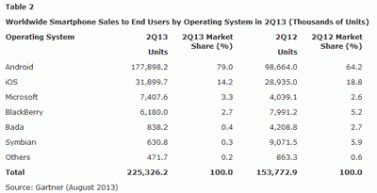It’s a fact: for the first time ever, smartphone sales have outgrown feature phone sales, bringing the mobile and mobility first reality closer and closer.
 Along with the recent predictions by Forrester on tablet sales, it’s clear that from the device perspective, consumerization and BYOD won’t be over anytime soon.
Along with the recent predictions by Forrester on tablet sales, it’s clear that from the device perspective, consumerization and BYOD won’t be over anytime soon.
The question is if you have a BYOD strategy and policy in place and how you will act as ever more people across the globe start using smart mobile devices and as new technologies are waiting around the corner. Moreover, it’s not just about the devices themselves but also about their impact on corporate networks and how we will do business with a mobile generation of consumers who are connecting, networking, sharing, communicating, buying and working with their mobile Swiss army knives.
Smartphones conquering Asia/Pacific, Latin America and Eastern Europe
Time for some numbers. According to Gartner worldwide mobile phone sales grew 3.6% in Q2 of this year as compared to the second quarter of last year. However, this relatively small growth of the mobile phone market is compensated by an impressive year-over-year growth of smartphone shipments in the second quarter.
The number of sold smartphones reached 225 million units worldwide, up 46.5% from Q2 of last year. Smartphone sales accounted for 51.8% of mobile phone sales in the second quarter of 2013. Sales of feature phones declined 21% YoY.
While developed markets are entering a stage in which tablets are becoming mainstream in the next few years, smartphones are conquering developing and dynamic regions such as Asia/Pacific, Latin America and Eastern Europe. With growth rates of respectively 74.1%, 55.7% and 31.6% in the three regions, it’s clear that the lessons learned regarding consumerization and BYOD will have to be deployed – if necessary in contextually adapted ways – on a global scale.
The year of BYOD beyond the buzz: are you ready?
And the year hasn’t come to an end yet. Gartner expects ‘flagship devices brought to market in time for the holidays, and the continued price reduction of smartphones will drive consumer adoption in the second half of the year‘.

It’s another sign that 2013 might indeed be the year of BYOD as many industry analysts predicted. Let’s hope it’s most of all a year in which BYOD and consumerization move from buzzwords to hands-on and working strategies as is the case for many business already.
There’s a risk involved with the ongoing research showing that mobile becomes ever more important. In recent years, the adoption of smartphones and tablets has been growing continuously so it’s probably not a surprise that smartphone sales have exceeded feature phone sales now either. However, it’s another milestone, showing how fast we’re moving towards a mobile consumer reality with unavoidable impact on work and business, across the globe. This is not just the case for typical BYOD scenarios but also for industries and activities whereby digital technologies take the lead, such as marketing.
The risk we take by ignoring the facts as they continue to be released is ignoring the reality of our business, employees and certainly customers. So, are you ready?






